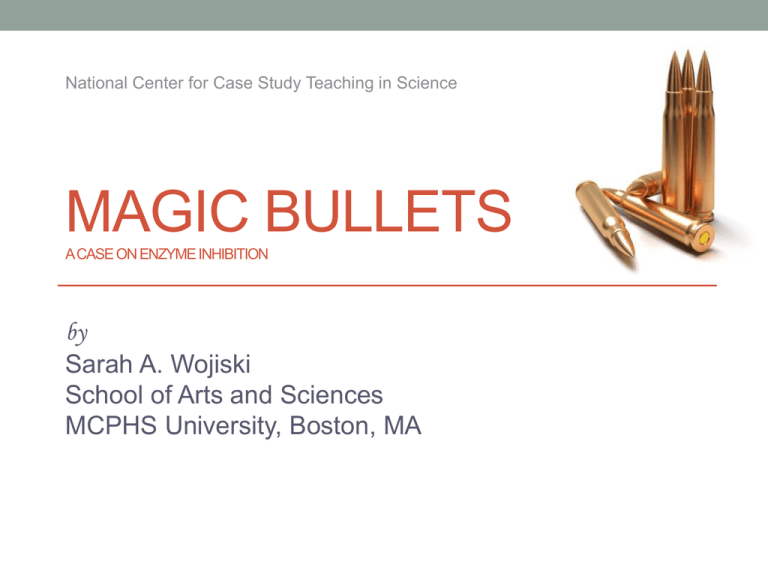
National Center for Case Study Teaching in Science
MAGIC BULLETS
A CASE ON ENZYME INHIBITION
by
Sarah A. Wojiski
School of Arts and Sciences
MCPHS University, Boston, MA
Just a routine checkup?
Oliver Casey, age 53, was visiting his doctor, Ariana Kagan, for
his annual physical. Aside from feeling a little more tired than
usual, which he attributed to increased responsibilities at work,
Oliver thought he was in good health. However, during the
physical examination, Dr. Kagan noted that Oliver had an
enlarged spleen.
“I’m going to order some blood work to see if we can figure out
why your spleen is enlarged. You may have an infection; it’s
probably nothing serious,” Dr. Kagan told Oliver.
Oliver left the doctor’s office that day feeling a little unsettled, but
hopeful that his enlarged spleen was caused by nothing more
than a virus.
The results
Oliver’s palms were sweaty and his heart was racing as he
sat across from Dr. Kagan in her office. He knew it couldn’t
be good news that he had been called in to discuss his
blood test results in person. Here are some of the findings:
Oliver’s white blood cell count
225 x 109 cells/L
Normal white blood cell count range
4.5 - 10 x 109 cells/L
Oliver’s Blood Smear
Normal Blood Smear
Clicker Question #1
Based upon the data shown in the previous slide, Oliver
appears to be suffering from
a. anemia: too few red blood cells
b. leukocytosis: too many white blood cells
c. leukopenia: too few white blood cells
d. polycythemia: too many red blood cells
The results, continued
Oliver sat in stunned silence while Dr. Kagan reviewed his blood
test results. “Your very high white blood cell count and enlarged
spleen prompted me to perform some additional testing on your
blood cells, and I’m afraid the results are not very good. The
results reveal that your blood cells contain a mutation that has
caused you to develop a blood disease called Chronic Myeloid
Leukemia, or CML. This is a slowly progressing cancer of the
blood cells. I am going to refer you to a doctor called a
hematologist, who specializes in blood diseases, who will
discuss your treatment options.”
“Chronic what?” replied Oliver, snapping out of his silent state.
Dr. Kagan explained to Oliver a little more about what CML is,
and what causes the disease.
Genetics of CML
• CML is characterized by an overproduction of a particular
type of white blood cell called the granulocyte
Granulocytes
Genetics of CML
• The vast majority of
cases of CML are
caused by a
chromosomal
translocation, a specific
type of mutation in which
two different
chromosomes swap
their DNA
Philadelphia
Chromosome
• Generates the
Philadelphia
chromosome, containing
the BCR-ABL fusion
protein
Chromosome
What is a kinase?
• BCR-ABL is a mutated version of the ABL protein, a
tyrosine kinase
• A kinase is an enzyme that catalyzes phosphorylation
reactions
• Transfers a phosphate group from ATP to the substrate
• Therefore, a kinase must be able to bind both ATP and its
substrate
Clicker Question #2
What part of an enzyme binds to the substrate?
a. Initiation site
b. Reaction site
c. Transformation site
d. Active site
e. Energy site
Clicker Question #3
Which of the following statements is FALSE?
a. The shape of the active site is determined by the amino
acid sequence of the enzyme.
b. The shape of the active site is constantly changing,
allowing the enzyme to bind many different substrates,
catalyzing many different chemical reactions.
c. When a substrate encounters the active site of its
enzyme, the substrate and enzyme become held
together by weak chemical bonds.
d. The active site of an enzyme is specific, recognizing
only one particular substrate.
Clicker Question #4
One function of the ABL kinase is to phosphorylate
substrates that tell white blood cells to grow and divide.
The ABL kinase is mutated in CML, giving rise to the BCRABL protein. Based on the normal function of ABL in white
blood cells, how do you think the mutated version of the
kinase (BCR-ABL) contributes to the development of CML,
a cancer of the white blood cells?
a. The kinase becomes overactive (too much enzyme
activity)
b. The kinase becomes inactive (too little or no enzyme
activity)
c. Not sure
Biology of CML
Normal Granulocytes
Cancerous Granulocytes
• ABL kinase is regulated
• BCR-ABL mutant kinase
• Granulocyte proliferation
is constitutively active
• Granulocyte proliferation
is unregulated
is regulated
ABL
Kinase
OFF
ABL
Kinase
ON
ABL
Kinase
ON
ABL
Kinase
OFF
A visit to the specialist
Oliver’s meeting with the hematologist, Dr. Clement, went well.
The doctor was optimistic about Oliver’s treatment options,
particularly since they had caught the cancer at a relatively early
stage.
“We will start you on a drug called imatinib, more commonly
known as Gleevec, and we will monitor your white blood cell
count to see how you respond to the drug,” Dr. Clement advised
Oliver. “Please see the receptionist to schedule a follow-up
appointment, and call the office if you experience any negative
side effects.”
Oliver left the office and picked up his prescription for Gleevec.
Clicker Question #5
Predict the mechanism of action of imatinib. Which of the
following mechanisms would best treat Oliver’s cancer?
a. Imatinib inhibits the function of all kinase enzymes.
b. Imatinib promotes the function of all kinase enzymes.
c. Imatinib inhibits the function of the BCR-ABL kinase.
d. Imatinib promotes the function of the BCR-ABL kinase.
How does imatinib work?
• Video: Gleevec® mechanism of action
https://youtu.be/alsAk4pyWlE
Clicker Question #6
What type of inhibitor is imatinib/Gleevec?
a. Non-competitive inhibitor
b. Competitive inhibitor
c. Not sure
Gleevec is a competitive inhibitor of BCRABL
• Competes with ATP for
binding site
• Blocks ATP from binding to
enzyme
Gleevec
CML
CML
Blood tests, blood tests, and more blood
tests!
Oliver had to admit it; he was getting used to the needle
stick. Eighteen months ago, Dr. Clement had warned
Oliver that it would be crucial to routinely monitor Oliver’s
blood to determine if the Gleevec was effectively fighting
his cancer. And Dr. Clement was right! There sure were a
lot of blood tests! And each time Oliver went to the
phlebotomy lab, he hoped that his test results would reveal
good news.
Clicker Question #7
White Blood Cell count (x 109 cells/L)
Refer to the graph below, charting some of Oliver’s blood
test results over the past 18 months. Based on this
graph, is Oliver’s treatment working?
a. Yes
Oliver's Blood Test Results
250
b. No
c. Not Sure
200
150
100
50
0
0
10
20
30
40
50
Time After Start of Treatment
(weeks)
60
70
Clicker Question #8
Predict what would happen to Oliver’s white blood cell
count if he stopped taking Gleevec.
a. His white blood cell count would stay within the normal
and healthy range.
b. His white blood cell count would drop below the normal
and healthy range.
c. His white blood cell count would rapidly increase above
the normal and healthy range.
Feeling good
Oliver was pleased. It had been about 18 months since his
initial diagnosis of CML, and it appeared that the Gleevec
was working. His white blood cell counts were back to
within normal range, and Dr. Clement indicated that other
testing revealed that the BCR-ABL mutation was no longer
detectable in his blood cells.
He would continue to have his blood tested every three
months, and was scheduled for a checkup with Dr. Clement
in 6 months, provided everything continued to look good.
Troubling Results
Dr. Benjamin Clement frowned as he looked at the latest
blood test results on his patient, Oliver Casey. Oliver had
been taking imatinib for a little over 21 months now, and
had responded beautifully. But the most recent blood work
showed Oliver’s white blood cell count was very high again.
And genetic analysis revealed the presence of the BCRABL mutant kinase in his cells again. It was time to call
Oliver in for a discussion.
What happened?
In groups of 2-3, discuss what could be the possible
causes of Oliver’s relapse. Be prepared to share at least
one possible cause of Oliver’s relapse with the rest of the
class.
Resistance!
Dr. Clement shared the bad news with his patient. “I’m
sorry, Oliver, but it appears that the Gleevec you have been
taking is no longer working against your cancer, and your
white blood cells are growing out of control again. We’ll do
some genetic testing to confirm, but the most likely cause
of this relapse is that the BCR-ABL gene has mutated once
again, and that mutation has rendered the protein resistant
to the Gleevec you have been taking.”
Video: mechanism of resistance to Gleevec
https://youtu.be/Jns9IiMrbeo
Clicker Question #9
According to the video, what do “resistance mutations” do
to render imatinib/Gleevec ineffective?
a. The resistance mutation allows Gleevec to bind to BCRABL, but not ATP.
b. The resistance mutation allows both Gleevec and ATP
to bind to BCR-ABL.
c. The resistance mutation allows ATP to bind to BCRABL, but not Gleevec.
d. The resistance mutation does not allow Gleevec or ATP
to bind to BCR-ABL.
Dasatinib vs. Imatinib
Dr. Clement sat in his office reviewing the most recent
genetic testing results with Oliver. “As I expected,” he said,
“you have acquired a resistance mutation in BCR-ABL that
is preventing Gleevec from doing its job. But the good news
is, we have another drug, dasatinib, that should be able to
counteract this mutation. I am going to call in a prescription
for dasatinib that you should start right away.”
Oliver was skeptical. If Gleevec wasn’t working against his
cancer, what was so magical about this new drug,
dasatinib?
How does dasatinib work?
• Video: dasatinib mechanism of action
https://youtu.be/3Tpz1et18gM
Clicker Question #10
What type of inhibitor is dasatinib?
a. Competitive inhibitor
b. Non-competitive inhibitor
c. Not sure
Clicker Question #11
Which of the following distinguishes the function of
dasatinib from the function of imatinib?
a. Dasatinib binds in the ATP-binding pocket of BCR-ABL,
while imatinib does not.
b. Dasatinib binds BCR-ABL in its inactive and active
conformation, while imatinib binds BCR-ABL only in its
inactive conformation.
c. Dasatinib is a competitive inhibitor of BCR-ABL, while
imatinib is a noncompetitive inhibitor of BCR-ABL.
d. Dasatinib prevents BCR-ABL from phosphorylating
substrates, while imatinib blocks other functions of
BCR-ABL.
And what does the future hold for Oliver?
• The development and use of tyrosine kinase inhibitors that
specifically block the function of BCR-ABL has revolutionized
the treatment of CML
• Mortality has dropped from 10-20% per year to 1-2% per year
• Treated as a chronic disease rather than life-threatening cancer
• Tyrosine kinase inhibitors are a lifelong treatment
• Stopping therapy often results in relapse
• Resistance mutations are always a threat; new tyrosine kinase
inhibitors that are effective against known resistance mutations
are currently in Clinical Trials
• Allogeneic bone marrow transplantation is the only truly
“curative” treatment available, though this is often not an option
due to patient age, other health issues, and lack of a suitable
donor
References
Jabbour, E. & Kantarjian, H. (2012). Chronic myeloid leukemia: 2012 update on
diagnosis, monitoring, and management. American Journal of Hematology, 87 (11), 103745.
National Cancer Institute. (May 23, 2014). Chronic Myelogenous Leukemia Treatment
(PDQ) Health Professional Version. Retrieved from
http://www.cancer.gov/cancertopics/pdq/treatment/CML/HealthProfessional.
National Cancer Institute. (June 27, 2014). Chronic Myelogenous Leukemia Treatment
(PDQ) Patient Version. Retrieved from
http://www.cancer.gov/cancertopics/pdq/treatment/CML/HealthProfessional
United States Food and Drug Administration. (August 26, 2013). Gleevec (Imatinib
Mesylate) Questions and Answers. Retrieved from
http://www.fda.gov/Drugs/DrugSafety/PostmarketDrugSafetyInformationforPatientsandPr
oviders/ucm110505.htm
Image Credits
Slide 3
Description: Chronic myeloid leukemia (CML): marked leucocytosis with granulocyte left shift.
Author: Paulo Henrique Orlandi Mourao
Source: http://commons.wikimedia.org/wiki/File:Chronic_Myeloid_Leukemia_smear_2009-04-09.JPG
Clearance: This file is licensed under the Creative Commons Attribution-Share Alike 3.0 Unported license.
Description: Blood smear from a normal healthy adult. Stained with Giemsa. Note the uniform staining and size of cells.
Author: Keith Chambers
Source: http://commons.wikimedia.org/wiki/File:Normal_Adult_Blood_Smear.JPG
Clearance:This file is licensed under the Creative Commons Attribution-Share Alike 3.0 Unported license.
Slide 6
Description: This diagram shows the hematopoiesis as it occurs in humans.
Author: A. Rad
Source: http://commons.wikimedia.org/wiki/File:Hematopoiesis_%28human%29_diagram.png
Clearance: GFDL-self. This image is released under the GFDL-self license and is considered freely distributable. This image or any
reproductions/customizations thereof (or any reproductions/customizations of its reproductions/customizations, and so forth) may NOT be sold
without my explicit consent.
Slide 7
Description: Philadelphia Chromosome Translocation
Author: A Obeidat
Source: http://commons.wikimedia.org/wiki/File:Philadelphia_chromosome.jpg
Clearance: This file is licensed under the Creative Commons Attribution-Share Alike 3.0 Unported license.
Slide 8
Description: Basic Phosphorylation reaction
Author: Boc13
Source: http://commons.wikimedia.org/wiki/File:Basic_phosphorylation_reaction.png
Clearance: This file is licensed under the Creative Commons Attribution-Share Alike 3.0 Unported license.
Slide 17
Adapted from : Mauro M J , and Druker B J. STI-571: Targeting BCR-ABL as therapy for CML. The Oncologist 2001;6:233-238
Video Credits
• Video clips adapted from:
• http://www.hhmi.org/biointeractive/gleevec-inhibits-cancer-causingkinase-bcr-abl
• http://www.hhmi.org/biointeractive/gleevec-resistant-form-kinasebcr-abl
Used with permission from the Howard Hughes Medical
Institute, copyright 2013. All rights reserved.
www.BioInteractive.org






